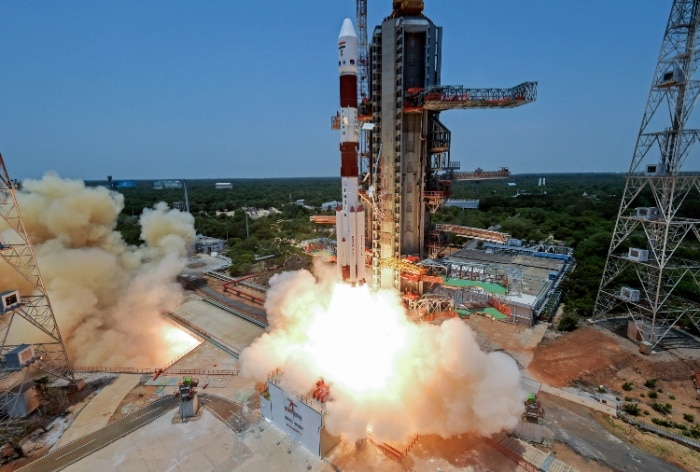
[ad_1]
ISRO revealed that the Aditya-L1 spacecraft has separated from the PSLV rocket and begun its 125-day voyage towards the Sun.

Sriharikota: The Aditya-L1 spacecraft has begun its 125-day voyage to the Sun after it successfully separated from the PSLV launch vehicle, ISRO said on Saturday, adding that the spacecraft was injected in the “precise orbit” as intended.
“Aditya L1 spacecraft has been injected in an elliptical orbit of 235 by 19,500 km which is intended, very precisely by the PSLV,” ISRO chief S Somanath said. He added that the Aditya-L1 has now begun its 125-day long journey towards the Sun.
Project Director Nigar Shaji, who was flanked by said the Union Minister Jitendra Singh, Mission Director Biju, and ISRO chief S Somanath at the Mission Control Center in Sriharikota, revealed that the spacecraft was injected into the orbit flawlessly by the PSLV “as always,” and that the solar panels are deployed.
Thanking Prime Minister Narendra Modi for supporting the space sector, Jitendra Singh termed the Aditya L1 launch as a “sunshine moment”
Aditya L1 mission objectives
Providing details about the Aditya-L1’s mission objectives, the Indian Space Research Organization (ISRO) said the goal is to study Sun’s outer atmosphere, adding that the Aditya-L1 will neither land on the Sun nor approach it any closer.
The spacecraft is expected to travel for about 125 days to reach the Halo orbit around the Lagrangian Point L1, which is considered closest to the sun.
Aditya-L1, weighing about 1,480.7 kg, is the first space-based observatory class to study the Sun.
The objectives of the Aditya-L1 mission includes study of the coronal heating, solar wind acceleration, Coronal Mass Ejections (CME), dynamics of solar atmosphere and temperature anisotropy.
How Aditya L1 will reach the Sun and monitor it?
Following today’s launch the Aditya-L1 stays in Earth-bound orbits for 16 days, during which it undergoes five maneuvers to gain the necessary velocity for its journey towards the Sun. Subsequently, the spacecraft undergoes a Trans-Lagrangian 1 insertion manoeuvre, marking the beginning of its 110-day trajectory to the destination around its destination.
Upon arrival at the L1, another manoeuvre binds Aditya-L1 to an orbit around the point, which is a balanced gravitational location between the Earth and the Sun.
The spacecraft spends its whole mission life of five years orbiting around L1 in an irregularly shaped orbit in a plane roughly perpendicular to the line joining the Earth and the Sun, ISRO said.
The strategic placement at the L1 Lagrange point ensures the spacecraft can maintain a constant, uninterrupted view of the Sun. This location also allows the satellite to access solar radiation and magnetic storms before they are influenced by Earth’s magnetic field and atmosphere, the space agency informed.
Additionally, the L1 point’s gravitational stability minimises the need for frequent orbital maintenance efforts, optimising the spacecraft’s operational efficiency.
Aditya-L1 will stay approximately 1.5 million km away from the Earth, directed towards the Sun, which is about 1 per cent of the Earth-Sun distance.
The PSLV C57 is the 59th flight of the launch vehicle, a trusted workhorses of ISRO and is the 25th mission using PSLV-XL configuration, ISRO said.
The atmosphere of the Earth as well as its magnetic field act as protective shield and block harmful wavelength radiations. In order to detect such radiation, solar studies are carried out from space.
Aditya-L1 payloads
Aditya-L1 mission carries seven scientific payloads to carry out the study.
The Visible Emission Line Coronagraph, which studies the solar corona and dynamics of Coronal Mass Ejections (CME), will be sending 1,440 images per day to the ground station for analysis on reaching the intended orbit.
The Solar Ultraviolet Imaging Telescope payload images the Solar photosphere and Chromosphere in near Ultraviolet and also measures the solar irradiance variations.
The Aditya Solar Wind Particle Experiment (ASPEX) and Plasma Analyser Package for Aditya (PAPA) payloads study the solar wind and energetic ions as well as the energy distribution.
The Solar Low Energy X-ray Spectrometer and the High Energy L1 Orbiting X-ray Spectrometer (HEL1OS) study the X-ray flares from the Sun over a wide X-ray energy range.
The Magnetometer payload is capable of measuring interplanetary magnetic fields at the L1 point.
The Science payloads of Aditya-L1 are indigenously developed with the close collaboration of various centers of ISRO.
(With PTI inputs)
[ad_2]